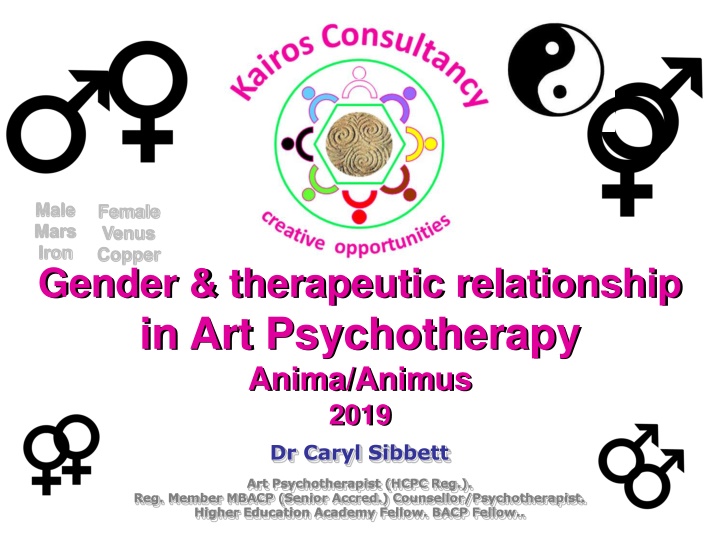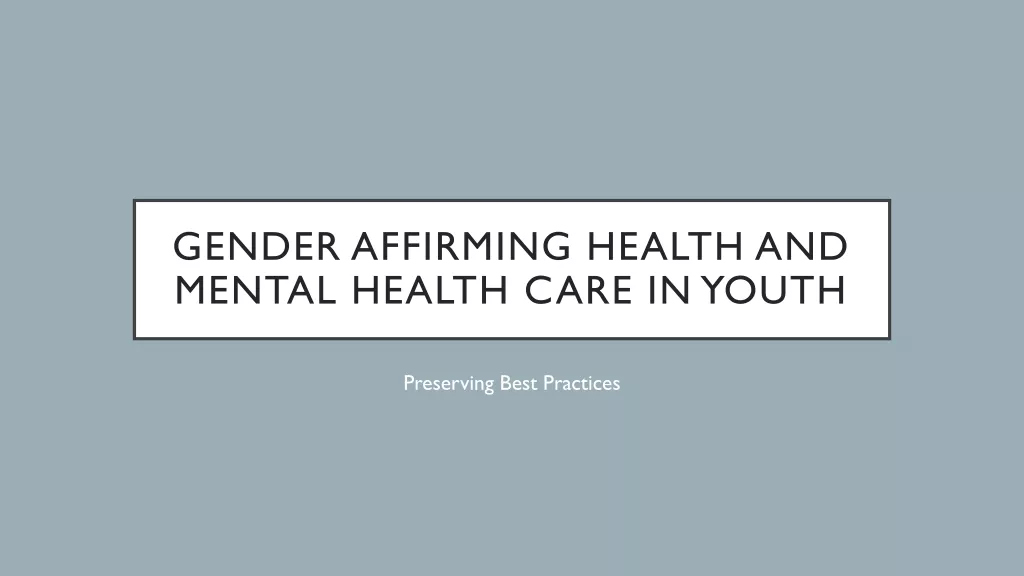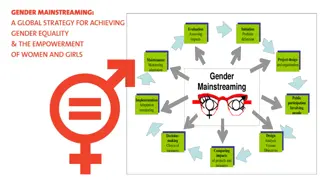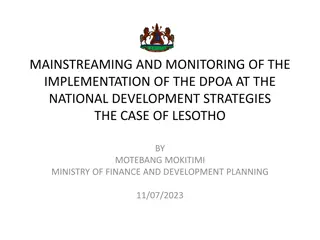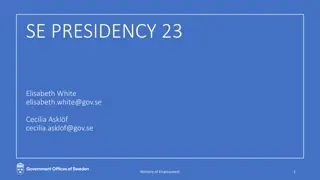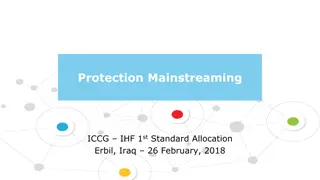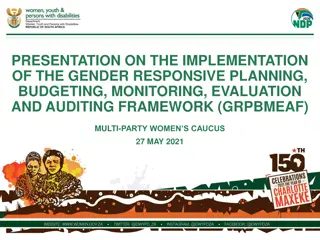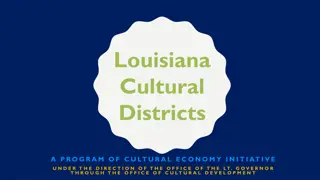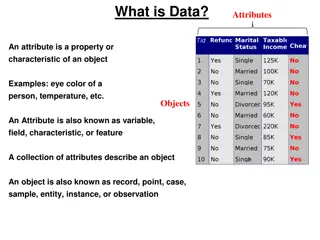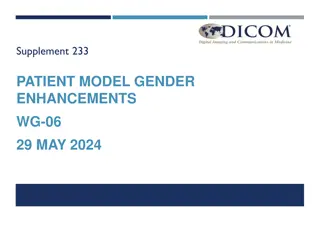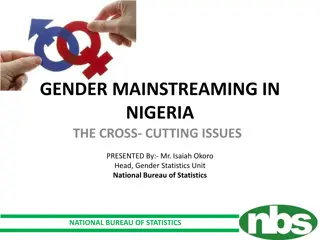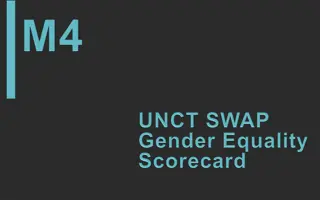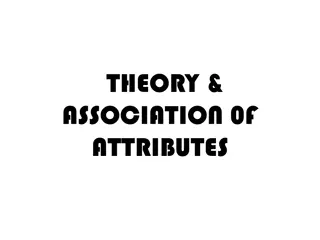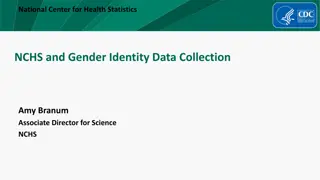Gender, Identity, and Art Therapy: Exploring Cultural Attributes and Gender Mainstreaming
Delve into the complexities of gender, identity, and their impact on art therapy through the lens of cultural attributes, gender mainstreaming, and the work lives of art therapists. Dr. Caryl Sibbett provides insights and reflections on how issues related to gender manifest in the field of art therapy.
Download Presentation

Please find below an Image/Link to download the presentation.
The content on the website is provided AS IS for your information and personal use only. It may not be sold, licensed, or shared on other websites without obtaining consent from the author.If you encounter any issues during the download, it is possible that the publisher has removed the file from their server.
You are allowed to download the files provided on this website for personal or commercial use, subject to the condition that they are used lawfully. All files are the property of their respective owners.
The content on the website is provided AS IS for your information and personal use only. It may not be sold, licensed, or shared on other websites without obtaining consent from the author.
E N D
Presentation Transcript
Male Mars Iron Female Venus Copper Gender & therapeutic relationship in Art Psychotherapy Anima/Animus 2019 Dr Caryl Sibbett Art Psychotherapist (HCPC Reg.). Reg. Member MBACP (Senior Accred.) Counsellor/Psychotherapist. Higher Education Academy Fellow. BACP Fellow..
CULTURAL ATTRIBUTES Reflect on / explore what attributes, traits, characteristics (e.g. adjectives) are associated with / expected of the following: . . . . Men Women Feminine Masculine Artists Art Therapists Dr Caryl Sibbett, Kairos Consultancy 2019 2
GENDER, IDENTITY? What is gender ? Does gender identity play a role in the work lives of art therapists? Gussak, 2008: 66) If so, how? Dr Caryl Sibbett, Kairos Consultancy 2019 3
GENDER (WHO, 2019) https://www.who.int/gender-equity-rights/knowledge/glossary/en/ Gender refers to the socially constructed characteristics of women and men such as norms, roles and relationships of and between groups of women and men. When individuals or groups do not fit established gender norms they often face stigma, discriminatory practices or social exclusion all of which adversely affect health. (WHO, 2019) Gender intersects with other factors that drive inequalities, discrimination and marginalization, such as ethnicity, socioeconomic status, disability, age, geographic location and sexual orientation, among others. (WHO) Sex: The different biological and physiological characteristics of males and females, such as reproductive organs, chromosomes, hormones, etc. (WHO) Dr Caryl Sibbett, Kairos Consultancy 2019 4
Gender mainstreaming (WHO, 2019) Gender mainstreaming The process of assessing the implications for women and men of any planned action, including legislation, policies or programmes, in all areas and at all levels. It is a strategy for making women s as well as men s concerns and experiences an integral dimension of the design, implementation, monitoring and evaluation of policies and programmes in all political, economic and societal spheres so that women and men benefit equally and inequality is not perpetuated.". (WHO, 2019) Dr Caryl Sibbett, Kairos Consultancy 2019 5
How might issues related to gender manifest / be relevant in art therapy? Dr Caryl Sibbett, Kairos Consultancy 2019 6
Gender etc & Art Therapy BOOKS Gender and Difference in the Arts Therapies (Hogan, 2019) Body, crafting, LGBT+, breaking & entering / sexual offending, body politics, mask &gender / conceal & reveal, motherhood, sexual identity, elder care, Gender Issues in Art Therapy(Hogan, 2003) Gender, sexuality, transgender, gay & lesbian, adolescence, pregnancy, domestic violence, Third World, etc. Feminist Approaches to Art Therapy (Hogan, 1997) Art Therapy,Race and Culture (Campbell et al, 2003) www.dhsspsni.gov.uk/publications/2002/RaceEqHealth.pdf Desire and the Female Therapist (Schaverien, 1995) Engendered gaze, transference, countertransference, art / client / therapist Dr Caryl Sibbett, Kairos Consultancy 2019 7
NI Mental Health (Action Mental Health, 2018) Northern Ireland has catastrophic levels of mental ill health. More people have died by suicide in the past 17 years than were killed during 30 years of conflict. We have 25% higher overall prevalence of mental health problems than England. We have the highest rates of incidences and annual presentation for self-harm in the UK. We have the highest suicide rate in the UK: 16.4 per 100,000 population compared to 10.3 in England, 9.2 in Wales and 14.5 in Scotland in 2014. Just over three quarters were males; and more suicides occurred in the most deprived areas. Prescription rates for mood and anxiety disorders were 66% higher for women than for men; and twice as high in the most deprived areas than the least deprived areas in 2013. (Mental Health Foundation s Fundamental Facts for Northern Ireland, October 2016) Northern Ireland spends less than half of England s per capita spend on supporting people with mental health problems and learning disabilities. Dr Caryl Sibbett, Kairos Consultancy 2019 8
Research: Mental Health in Northern Ireland: Stigma in NI Women are more likely to experience depression, whilst men are more likely to experience personality disorders and suicide. (Betts & Thompson, 2017: 10) In NI, stigma is still a major deterrent to seeking help for mental illness. Research found that internalised stigma (holding stigmatised views about oneself), and treatment stigma (stigma associated with seeking or receiving treatment for mental illness), were the main factors in not seeking help. (Betts & Thompson, 2017: 4) The World Health Organisation (WHO) stated, The single most important barrier to overcome in the community is the stigma and associated discrimination towards persons suffering from mental and behavioural disorders. (Betts & Thompson, 2017: 39) Dr Caryl Sibbett, Kairos Consultancy 2019 9
Research: Mental Health in Northern Ireland: Stigma Clement et al (2015) found types of mental health- related stigma impacting on help-seeking: Anticipated stigma anticipation of personally being perceived or treated unfairly; Experienced stigma the personal experience of being perceived or treated unfairly; Internalised stigma holding stigmatising views about oneself; Perceived stigma views about the extent to which people in general have stigmatising attitudes/behaviour towards people with mental illness; Stigma endorsement - participants own stigmatising attitudes/behaviour towards people with mental illness); and Treatment stigma the stigma associated with seeking or receiving treatment for mental ill health (Betts & Thompson, 2017: 39) anti-stigma programmes should focus on countering stereotypes such as weakness and craziness , social judgement and rejection, employment discrimination and shame/embarrassment (Betts & Thompson, 2017: 40) Dr Caryl Sibbett, Kairos Consultancy 2019 10
ART? Can you name: The top 10 male artists known to the general public? The top 10 female artists known to the general public? The top transexual, transgender artists known to the general public? Dr Caryl Sibbett, Kairos Consultancy 2019 11
Socially constructed All of our efforts as creative arts therapists to document our contributions are constrained by the greater value our society places on control versus empathy, external versus internal concerns, managing versus caring, aggression versus understanding, business versus the arts men versus women. (Johnson, 1989, p.236, cited in Gussak, 2008, p.65) Dr Caryl Sibbett, Kairos Consultancy 2019 12
Socially constructed Wadeson (1989), for example, stressed that art therapists should not succumb to the pressures of the masculine world placed onto the female-dominated art therapy profession. She believed that in response to the demands to align themselves with male- dominated health-professions, art therapists often feel pressured to analyze, interpret, diagnose, and assess and that we often feel the need to prove the merits of our work by producing research that justifies our clinical interventions (p. 327). By equating masculinity with the tendency to quantify, and in essence to be more scientific, Wadeson asserted that art therapists run the risk of losing their desired feminine traits: spontaneity, caring, and nurturance. (Gussak, 2008, p.66) Dr Caryl Sibbett, Kairos Consultancy 2019 13
Engendered gazes (Schaverien, 1995) Berger (1973: 47),in Ways of Seeing, writes: men act and women appear. Men look at women. Women watch themselves being looked at. This determines not only most relations between men and women but also the relation of women to themselves. The surveyor of woman in herself is male: the surveyed female. Thus she turns herself into an object -- and most particularly an object of vision: a sight. Engendered gazes in art therapy: erotic countertransference; aesthetic countertransference." (Schaverien, 1995) Dr Caryl Sibbett, Kairos Consultancy 2019 15
Above and Below: Toward a Social Geometry of Gender (Gilmore, 1996) Geometry. Topography Up / down; above / below Status: power? Height. When it comes to gender schema (Bem, 1983) males are almost always on top in such vertical analogies and metaphors (Gilmore, 1996: 54) Voice / silence interiority/exteriority inside, outside (Hirschon, 1981: 72) Dr Caryl Sibbett, Kairos Consultancy 2019 16
I know my place Dr Caryl Sibbett, Kairos Consultancy 2019 17
POWER? Top--Bottom Dr Caryl Sibbett, Kairos Consultancy 2019 18
Is the world upside down? What it is like to see the world from down there. (Salcedo, 2007) Doris Salcedo Dr Caryl Sibbett, Kairos Consultancy 2019 19
LINKS TO OTHER THEORIES? Splitting: Good Breast / Bad Breast Melanie Klein Conditions of Worth Carl Rogers Social identity theory - Henri Tajfel In-group / Out-group; them and us http://www.simplypsychology.org/social-identity-theory.html Scapegoating Schaverien etc. OR Social inclusion; integration; Acceptance; working with and through Dr Caryl Sibbett, Kairos Consultancy 2019 20
GENDER: Boys? Kindlon and Thompson (2000) argue that boys are miseducated away from inner emotions: The road not taken. Turning boys away from their inner life. (Kindlon and Thompson, 2000: 1). We call this process, in which a boy is steered away from his inner world, the emotional miseducation of boys. There is a need to develop emotional literacy (Kindlon and Thompson, 2000: 4). Dr Caryl Sibbett, Kairos Consultancy 2019 22
GENDER: Girls? Pipher (1995) argues that in early adolescence, girls: crash and burn in a social and developmental Bermuda Triangle. They lose their assertive, energetic and tomboyish personalities and become more deferential, self- critical and depressed, They report great unhappiness with their own bodies. Fairy tales capture the essence of this phenomenon. Such as the Sleeping Beauty (Pipher, 1995: 19) and Ophelia in which play Ophelia comes to live to please her father and Hamlet Her value is determined utterly by their approval. In adolescence, Their problems are complicated and metaphorical eating disorders, school phobias and self-inflicted injuries. (Pipher, 1995: 20). Pink: colour stereotyping? (Koller, 2008) Dr Caryl Sibbett, Kairos Consultancy 2019 23
Binary? Diversity! Fault line of gender (Moore, 1988; Papenek, 1990) There has been a postmodern shift: the binary difference has been superseded by one that is concerned with the diversity of gendered and sexual identities and practices (Cameron, 2005: abstract) Dr Caryl Sibbett, Kairos Consultancy 2019 24
GENDER IN ART THERAPY? Art therapy: more females than males (Franklin, 2007; Gussak, 2008) 70-95% (Waller, 2001) Art therapists gender: I use gender to mean the classification of people as feminine and masculine. This classification is culturally constructed and is dependent on, but different from, sex. Whereas gender relates to culture, sex relates to biology and generally divides individuals into the categories of male and female. Gender identity here refers to a person s self identification: one s inner sense of one s sex. (Gussak, 2008: 64) Dr Caryl Sibbett, Kairos Consultancy 2019 25
Unpacking gender in art therapy: The elephant at the art therapy easel (Hogan & Cornish, 2014) Dr Caryl Sibbett, Kairos Consultancy 2019 26
Gender in therapeutic relationship Survey: how gender and sexual orientation etc. influence the therapeutic relationship (Hogan & Cornish, 2014) How important is your client's sex (gender) to the way you would commence art therapy? How important is your client's sex (gender) to the way you would conduct art therapy? Responses indicated a rather mobile view of what gender could be in the therapeutic relationship that a female therapist could be experienced as male, or that a male aspect of the female therapist could come to the fore in the encounter. Dr Caryl Sibbett, Kairos Consultancy 2019 27
Figure 1. Your gender. just under 12% of registered British art therapists completed the questionnaire, Dr Caryl Sibbett, Kairos Consultancy 2019 28
Gender stereotypes? Stereotypes? Johnson (1989) reasoned that art therapy is attractive to women due to their natural nurturing and creative characteristics. He also surmised that the difficulties that art therapists have in promoting professional identity could be due to how society views women: All of our efforts as creative arts therapists to document our contributions are constrained by the greater value our society places on control versus empathy, external versus internal concerns, managing versus caring, aggression versus understanding, business versus the arts men versus women. (p.236) (Gussak, 2008: 65) Dr Caryl Sibbett, Kairos Consultancy 2019 29
Gender stereotypes? Gussak (2008: 66)summarises how: Wadeson (1989) stressed that art therapists should not succumb to the pressures of the masculine world placed onto the female-dominated art therapy profession. Wadeson (1989) due to demands to align with male-dominated health-professions, art therapists often feel pressured to analyze, interpret, diagnose, and assess and that we often feel the need to prove the merits of our work by producing research that justifies our clinical interventions (p.327). By equating masculinity with the tendency to quantify, and in essence to be more scientific, Wadeson asserted that art therapists run the risk of losing their desired feminine traits: spontaneity, caring, and nurturance. In the clinical arena, we care and connect (female) rather than judge and apply rules. And yet we are often pressured to do the latter: to assess (i.e., judge according to rules male) (p.329). Gender stereotypes are reinforced and art therapists are warned to choose one gender identity over another, in this case, the feminine over the masculine. (Gussak,2008: 66) Dr Caryl Sibbett, Kairos Consultancy 2019 30
challenging gendered perceptions art therapists of all gender identities need to analyze how gender affects their perceptions of themselves and of their profession, and actively strive to counter dominant gender stereotypes surrounding them. I do not mean that we should completely reject the notion that art therapists strong suits include being nurturing and creative. Rather, I mean that (among other things) we should fight the idea that being nurturing and creative is a strictly feminine trait. Through challenging our own gendered perceptions, as well as those of society, we can and will move forward as a profession. (Gussak, 2008: 69) Dr Caryl Sibbett, Kairos Consultancy 2019 31
In reality, in the circle of right relationship, there is no above and no below, no in or out - all are together in the sacred circle. Dhyani Ywahoo, Etowah Band, Tsalagi (Cherokee) (McFadden, 1994: 14) Dr Caryl Sibbett, Kairos Consultancy 2019 32
Mestiza consciousness Mestiza an Aztec word (meaning torn between ways ) used to refer to one who moves between cultures or is simultaneously in two cultures (Anzald a, 1997: 234). Advocates: Mestiza consciousness : Anzaldua s(1987, 1997)concept of a mestiza consciousness as a dynamic new mythos capable of breaking down dualistic hegemonic paradigms. (Aigner- Varoz, 2000) E.g. masculine / feminine; good / bad; art / therapy Dr Caryl Sibbett, Kairos Consultancy 2019 33
Mending divisions (Franklin, 2007: 9) Integrate opposites: As artists and therapists, we have a method to examine, confront, and integrate opposites, especially splits inherent in power and oppression. For me, art is the primary unifying metaphor that leads the way in this pursuit of mending divisions. (Franklin, 2007: 9) The symbolic is that which draws together, ties, integrates the individual in himself and with his group (May, 1972: 138) Symbolic: integrative, throw together (sym-bollein) Dr Caryl Sibbett, Kairos Consultancy 2019 34
The Transcendent function Jung s (1953-1979; 1961) concept of the Transcendent function His original essay on the transcendent function was written in 1916; World War 1 was raging. The transcendent function has a central role in the self-regulating nature of the psyche, individuation, and the Self s drive toward wholeness. (Miller, 2012, p.5) SYNTHESIS Thesis Antithesis Dr Caryl Sibbett, Kairos Consultancy 2019 35
The Transcendent Function arising from the union of conscious and unconscious contents (Jung, 1957/1960, p.69) conscious and unconscious opposites can be bridged by the emergence of a symbol from the fantasy-producing activity of psyche. The symbol in turn, produces something that is not merely an amalgam of or compromise between the two opposites but rather a living third thing a living birth that leads to a new level of being, a new situation (Jung, 1957/1960 p.90) from which emerges some new position or perspective (Miller, 2012, p.4) (Solomon, 1994) Dr Caryl Sibbett, Kairos Consultancy 2019 36
Transcendent a dialogue between the unconscious and conscious through which a new direction emerges (Miller, 2012: 3) Transcendent: transition from one attitude to another. A shift offering a new synthesis of what was perceived as opposites. (Miller, 2012: 4) Integration; Individuation; wholeness (Miller, 2012) Dr Caryl Sibbett, Kairos Consultancy 2019 37 (Miller, 2004: front cover)
transcendent function insights of analytical psychology can be useful in understanding social, political, and cultural aspects of our lives in which the collective psyche is the currency of exchange. (Singer, 2010: 234) Relevance of transcendent function to e.g. men and women; black and white ( race , ethnicity); homophobia; political aggression, violence & conflict in society. Dr Caryl Sibbett, Kairos Consultancy 2019 38
Descendent Function (Singer, 2010: 235) Descendent Function Singer (2010) explores an opposite phenomenon, the descendent function as it appears in the collective society wherein symbolic material can create the division of groups of people into opposites, mobilizing destructive rather than transformative experience. (Meador, Samuels & Singer, 2010: abstract). Dr Caryl Sibbett, Kairos Consultancy 2019 39
Anima/animus Anima/animus archetypal concepts Jung says The animus and the anima should function as a bridge or a door, leading to the images of the collective unconscious, as the persona should be a sort of bridge to the world (Jung, 1961: 392) (Kast, 2006: 116) Every man carries within him the eternal image of woman; not the image of this or that particular woman, but a definitive feminine image (Jung, 1925/1972: para.338). Further, women carry with them the eternal image of the masculine. Here Jung is pointing to the archetypal nature of anima and animus, and he is talking about projection of these inner figures onto real women and men. (Kast, 2006: 116) Dr Caryl Sibbett, Kairos Consultancy 2019 40
Post-Jungian development Anima / animus: post-Jungian concept not gender specific both can be constellated in men and women, and they often appear in tandem, as couples Anima and animus regulate relationship in the widest sense We could even call them archetypes of relationship and bonding. Linked to parental complexes. (Kast, 2006: 127) Linked to the Anima Mundi (Kast, 2006: 120, 127); the world soul; connection between all living things on the planet Platonic ideas: this world is indeed a living being endowed with a soul and intelligence ... a single visible living entity containing all other living entities, which by their nature are all related (Plato, Timaeus, 30b c, 33b) Dr Caryl Sibbett, Kairos Consultancy 2019 41
animus & anima as the combination of sun & moon Dr Caryl Sibbett, Kairos Consultancy 2019 42
ART-MAKING Potential themes: Gender Anima / Animus (Jung, 1981) Engendered gazes (Schaverien, 1995) Middle way (for male art therapists or female art therapists) Dr Caryl Sibbett, Kairos Consultancy 2019 43
Cross-cultural symbolism? Dr Caryl Sibbett, Kairos Consultancy 2019 44
Middle man perspective A new paradigm for male art therapists: a middle man perspective. A middle man is one who skillfully negotiates stereotypic androcentric notions of masculinity by incorporating into his self-structure a stance that confronts patriarchal oppression and cultural blind spots surrounding power and privilege so easily ignored by many western Caucasian men. (Franklin, 2007: abstract) Dr Caryl Sibbett, Kairos Consultancy 2019 45
the Middle Man: Anima Rising (Franklin, 2007) Emancipation from division: Bourdieu [2001] further states that as women are diminished and denied by patriarchal structures, men are also imprisoned by their dominant position. This internment exists as the sad separation from the feminine. Emancipation from this division is key to a full exchange between all genders. (Franklin, 2007: 6) Discrimination; us V them; conflict between cultures Occupying the Middle with Empathic Discernment (Franklin, 2007: 8) Dr Caryl Sibbett, Kairos Consultancy 2019 46
middle man - middle woman? Anima, Animus: archetypal capacities(Jung, 1968, 1996) Jung (1968) taught about the contrasexual male (anima) and female (animus) qualities that pulse throughout a body, signaling the call to transformation and integration of opposing biological and cultural forces. (Franklin, 2007: 4) Can we skillfully work with these biological and cultural tensions , or are we split ? (Franklin, 2007: 4) Gilligan (2003, cited in Franklin, 2007): loss of voice; earlier for boys (& hide gentle nurturing tenderness ) (Franklin, 2007: 4-5) Dr Caryl Sibbett, Kairos Consultancy 2019 47
ANIMA, ANIMUS Anima & Animus: contrasexual Singer (1994: 179) describes the anima and animus as twin archetypes of the contrasexual, with the anima being the eternal feminine aspect or soul figure in a man and the animus being the eternal masculine in the woman. The formation of the anima and animus is attributed to three main factors: the archetypal, the developmental and the social (Singer, 1994: 186). They can be guides to the unconscious if we are open to them (Singer, 1994: 194). Anima & animus: Jung often called them archetypes, but also referred to them as complexes (Young-Eisendrath, 1997: 32) Dr Caryl Sibbett, Kairos Consultancy 2019 48
MIDDLE WAY? Emancipation from division: Bourdieu [2001] further states that as women are diminished and denied by patriarchal structures, men are also imprisoned by their dominant position. This internment exists as the sad separation from the feminine. Emancipation from this division is key to a full exchange between all genders. (Franklin, 2007: 6) Occupying the Middle with Empathic Discernment (Franklin, 2007: 8) Mestiza consciousness : Anzaldua s (1987, 1997)concept of a mestiza consciousness as a dynamic new mythos capable of breaking down dualistic hegemonic paradigms. (Aigner-Varoz, 2000) Dr Caryl Sibbett, Kairos Consultancy 2019 49
